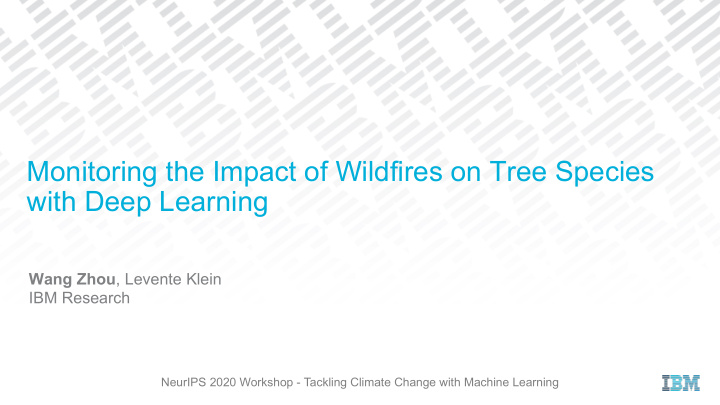



Monitoring the Impact of Wildfires on Tree Species with Deep Learning Wang Zhou , Levente Klein IBM Research NeurIPS 2020 Workshop - Tackling Climate Change with Machine Learning
Growing wildfires due to climate change By: NASA 1979 - 2013 Change in Frequency of Long Fire Weather Seasons (%) -52 -26 0 26 52 2
Wildfires affect tree species none *Fairman et al., Journal of Vegetation Science 28, no. 6 (2017): 1151-1165. Conventional approaches to monitor tree species 1) Select a few burnt sites 2) Go to the sample sites, and manually document tree types/sizes/status… 3) Extrapolate to the whole area 4) Repeat 1-3 for another couple of years 3
Our approach: classify tree species with DL Data Label Model Wildfires • NAIP data from PAIRS Sierra Nevada Vegetation • Modified ResNet34 • RGB-NIR Mapping Report (2011) • 32 x 32 x 4 image tiles Fletcher Fire • Data cleaning 2007 • Data from 2009-2018 • Five classes • 92% accuracy on test Swedes Fire 2013 Wall Fire 2017 4
Trees regrow after a wildfire 2009 2012 Fletcher Fire Modoc County, CA 8,121 Acres July 10, 2007 - July 19, 2007 2014 2016 2018 5
Repeated wildfires change the landscape Swedes Fire Butte County, CA 2,264 Acres 2009 2012 2014 August 16, 2013 - August 22, 2013 Camp Fire Butte County, CA 153,336 Acres Wall Fire November 8, 2018 - 2016 Butte County, CA 2018 November 25, 2018 6,033 Acres July 7, 2017 - July 17, 2017 6
Conclusion • We propose a deep learning pipeline to classify and track tree species to study the impact of wildfires • Geospatial data platforms provide easy access to data and model development • Multi-year remote sensing data help to study climate change at large scale • Quantitative estimate of land cover changes before and after wildfires for multiple vegetation species are conducted • The tool can help rangers and foresters to track vegetation regeneration and forest compositions Link to paper: https://arxiv.org/abs/2011.02514 7
Recommend
More recommend